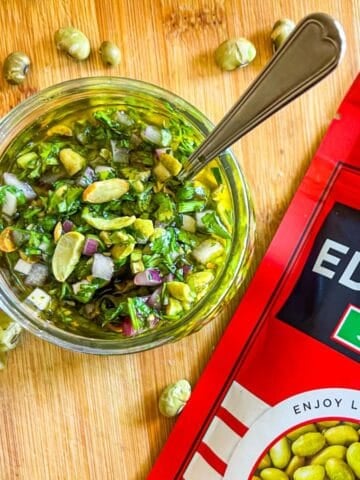Today, we explore of one of Japan's most beloved and iconic dishes - Sukiyaki. At the heart of this masterpiece is a simple, soul-stirring Sukiyaki Sauce Recipe. This 4-ingredient Japanese sauce perfectly balances savory and sweet flavors and elevates this simple hot pot to a culinary masterpiece.

Japanese hot pots often involve thin slices of tender beef, an assortment of fresh vegetables, and sometimes tofu simmering in a rich, umami-packed broth of sukiyaki and dashi. It's a taste sensation and a fun experience, usually heated by a portable stove and cast iron pot in the middle of the dining table.
For this simplified pescatarian version of the popular Japanese hot pot dish, I added nutty buckwheat noodles to the broth, creating the perfect, chewy balance to our sweet and savory broth.
It's fresh and deeply flavorful. The perfect seafood dish!
Ingredients for this recipe:

Ingredients for Sauce:
Light soy sauce: salty, savory and full of umami, soy sauce is the backbone of this popular sauce.
Mirin: This essential Japanese sweet condiment counterbalances the savory soy sauce. It also acts as a natural tenderizer for the fish and other ingredients. If you can't find mirin, you can make sukiyaki using equal parts light soy sauce and sake.
Sake: a traditional Japanese rice wine, sake serves as both a flavor enhancer and a cooking liquid in sukiyaki sauce. It adds complexity to the sauce, contributing a mild alcoholic note and accentuating the umami flavors of the other ingredients. If you can't find sake or prefer not to cook with alcohol, you can omit it or add a little bit of dry sherry or white wine for a similar effect.
Sugar: the recipe calls for raw sugar, which gives a clean sweetness to the sauce. Substitute your favorite sugar substitute or brown sugar.
For Cod & Soba Bowl:
Dashi: It is a traditional cooking stock or broth that is the foundation for numerous dishes, ranging from soups and stews to sauces and dressings. Homemade dashi is made by simmering a few simple ingredients, like dried kombu (seaweed) and bonito flakes (dried fish), in water. You can find instant dashi granules at your local Japanese market, and it makes the perfect quick and easy dashi broth for all your Japanese cooking. (Instant dashi is what I use!)
Spinach: substitute your favorite quick-cooking green, including baby bok choy, pea pods or zucchini noodles.
Full ingredient list and measurements included in printable recipe card below.
Step by step instructions:
To make the sukiyaki sauce, combine mirin, sake, soy sauce and raw sugar in a large skillet. Bring the mixture to a simmer over medium heat. Stir and simmer for 2-3 minutes, until sugar has fully dissolved.


To make sukiyaki with cod, add 3 cups of dashi broth to the skillet of sukiyaki sauce. (If making dashi from instant broth granules, combine 2 teaspoons dashi granules with 3 cups water for the perfect broth flavor.) Bring the dashi and sukiyaki mixture up to a simmer.

Add fresh cod fillets and cover the skillet. Allow the broth to simmer gently, poaching the fish.

Cook for 6-8 minutes, then add the fresh spinach, wilting the leaves in the final minute of cooking.

To serve, add cooked soba noodles to bottom of bowl. Top the buckwheat noodles with wilted spinach, then a cod fillet. Pour broth over cod, then garnish with scallions and chilis.

Looking for more Japanese Recipes?
- Easy Miso Ramen Tare Recipe
- Spicy Tuna Recipe (for sushi stacks and bowls)
- Hibachi Salmon Recipe
- Japanese Shrimp Curry (with S&B Curry Roux)
FAQ's for Sukiyaki Sauce with Cod & Soba:
Yes, you can prepare sukiyaki sauce in advance. After making the sauce, let it cool to room temperature, then transfer it to an airtight container or bottle and refrigerate. It should stay fresh for a few weeks in the refrigerator.
If you can't find mirin, you can make sukiyaki using equal parts light soy sauce and sake. To make up for the lost sweetness in mirin, add 3 tablespoons sugar, then taste the finished sauce and add more, if needed.
If you can't find sake or prefer not to cook with alcohol, you can omit it or add a little bit of dry sherry or white wine for a similar effect. Alternately, you can make sukiyaki sauce using equal parts light soy sauce and mirin. Be sure if making sukiyaki without sake, omit the sugar. Mirin is sweeter than sake, so no additional sugar is needed. However, keep in mind that the flavor will differ slightly from the traditional sukiyaki sauce.
Soy sauce, which is a key ingredient in sukiyaki sauce, is usually made from soybeans and wheat. If you need a gluten-free version, look for gluten-free soy sauce or tamari, which is a wheat-free soy sauce alternative.
Absolutely! The sweetness of the sauce can be adjusted to your taste. If you prefer a sweeter sauce, add a bit more sugar or mirin. On the other hand, if you prefer a less sweet sauce, reduce the amount of sugar or mirin in the recipe.
To store, transfer sukiyaki sauce to an airtight container and keep in the refrigerator for up to 2 weeks. To store leftover cod and soba, keep in refrigerator for up to 3 days.

Cod and Soba in Easy Japanese Sukiyaki Sauce Recipe
- Total Time: 30 minutes
- Yield: 4
Ingredients
Sukiyaki Sauce:
½ cup mirin
½ cup soy sauce
½ cup sake
2 tablespoons raw sugar
Sukiyaki with Cod & Spinach:
Sukiyaki sauce (recipe above)
3 cups dashi (3 cups water, 2 teaspoon dashi powder)
4 4-5 ounce cod fillets
10 ounces fresh spinach
6 ounces dry soba noodles, cooked and rinsed
¼ cup scallions
Sliced red chilis, optional
Instructions
To make the sukiyaki sauce, combine all ingredients in a large skillet and bring up to a simmer. Stir and cook gently for 2-3 minutes, until sugar has fully dissolved.
To make sukiyaki with cod, add 3 cups of dashi broth to the skillet of sukiyaki sauce. (If making dashi from instant broth granules, combine 2 teaspoons dashi granules with 3 cups water for the perfect broth flavor.) Bring the dashi and sukiyaki mixture up to a simmer.
Add fresh cod fillets and cover the skillet. Allow the broth to simmer gently, poaching the fish. Cook for 6-8 minutes, then add the fresh spinach, wilting the leaves in the final minute of cooking.
To serve, add cooked and rinsed soba noodles in bottom of bowl. Top the buckwheat noodles with wilted spinach, then a cod fillet. Pour over broth.
Garnish with scallions and chilis.
Notes
Cod, snapper, rockfish or haddock are all good options for this fish recipe.
Traditional sukiyaki is served with a raw or soft-boiled egg for dipping the proteins.
- Prep Time: 10
- Cook Time: 20
- Category: Easy Recipes
- Method: Stove Top
- Cuisine: Asian, Japanese







Leave a Reply